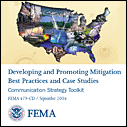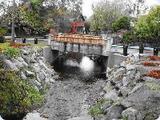Mitigation Best Practices Portfolio
In the wake of disasters, people often wonder whether there is a way to protect both people and property from such devastating losses. The answer is a resounding "YES!" Mitigation is the way to provide that protection. Hazard mitigation means taking action to reduce or prevent future damage, preferably before a disaster strikes.
 Best Practices e-mail updates
Best Practices e-mail updates
|
||||
Learn from Others' Success
Throughout the United States, many individuals, businesses, and communities have been taking action to combat disasters. They are winning.
To see how others are protecting their lives and property, see our:
Best Practices Portfolio Collection of illustrated stories, ideas, activities, and projects that show how others have worked to reduce or prevent damage from disasters.
Case Studies
In-depth, analytical information about innovative projects throughout the United States that deal with all types of hazards.Mitigation Best Practices (Hurricane Katrina)
These Best Practices highlight Gulf Coast mitigation projects that successfully protected properties and reduced financial losses during Hurricane Katrina (2005).
Share your Success
If you have taken measures to prevent losses from disasters at home, at work, or in your community, help us tell YOUR story.
If your community was creative or took exceptional steps in implementing planning and prevention measures, executing sound floodplain management practices, providing mitigation training, or conducting outreach and public awareness activities, let other communities read about it.
There are two ways to submit your story:
Online: Complete the Online Submission Form
By Mail: Download the Submission Worksheet
Once you submit your Best Practice or Case Study, we will review your information and possibly include your story in our nationwide collection of Best Practices.
Additional Resources
 Telling the Tale of Disaster Resistance: A Guide to Capturing and Communicating the Story provides some of the “best practices” of those who have promoted disaster-resistance efforts throughout the country. In this guide, you'll find the key considerations for successfully telling the tale of disaster resistance—developing story leads, researching and documenting projects, creating a finished product, and promoting those projects.
Telling the Tale of Disaster Resistance: A Guide to Capturing and Communicating the Story provides some of the “best practices” of those who have promoted disaster-resistance efforts throughout the country. In this guide, you'll find the key considerations for successfully telling the tale of disaster resistance—developing story leads, researching and documenting projects, creating a finished product, and promoting those projects.
 Developing and Promoting Mitigation Best Practices and Case Studies - Community Strategy Toolkit, is designed to help guide efforts to capture and promote effective mitigation techniques being employed throughout the country to reduce adverse impacts of disasters.
Developing and Promoting Mitigation Best Practices and Case Studies - Community Strategy Toolkit, is designed to help guide efforts to capture and promote effective mitigation techniques being employed throughout the country to reduce adverse impacts of disasters.
Last Modified: Thursday, 04-Oct-2007 16:01:43 EDT

